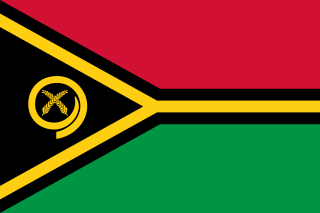
Vanuatu, officially the Republic of Vanuatu, is an island country located in the South Pacific Ocean. The archipelago, which is of volcanic origin, is 1,750 km (1,090 mi) east of northern Australia, 540 km (340 mi) northeast of New Caledonia, east of New Guinea, southeast of the Solomon Islands, and west of Fiji.

Bungee jumping, also spelled bungy jumping, is an activity that involves a person jumping from a great height while connected to a large elastic cord. The launching pad is usually erected on a tall structure such as a building or crane, a bridge across a deep ravine, or on a natural geographic feature such as a cliff. It is also possible to jump from a type of aircraft that has the ability to hover above the ground, such as a hot-air-balloon or helicopter. The thrill comes from the free-falling and the rebound. When the person jumps, the cord stretches and the jumper flies upwards again as the cord recoils, and continues to oscillate up and down until all the kinetic energy is dissipated.

A skirt is the lower part of a dress or a separate outer garment that covers a person from the waist downwards.

A lavalava, also known as an 'ie, short for 'ie lavalava, is an article of daily clothing traditionally worn by Polynesians and other Oceanic peoples. It consists of a single rectangular cloth worn similarly to a wraparound skirt or kilt. The term lavalava is both singular and plural in the Samoan language.

The Damara, plural Damaran are an ethnic group who make up 8.5% of Namibia's population. They speak the Khoekhoe language and the majority live in the northwestern regions of Namibia, however they are also found widely across the rest of the country.

Tanna is an island in Tafea Province of Vanuatu.
Kava cultures are the religious and cultural traditions of western Oceania which consume kava. There are similarities in the use of kava between the different cultures and islands, but each one also has its own traditions.
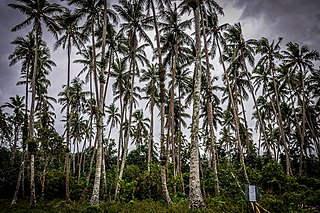
Pentecost Island is one of the 83 islands that make up the South Pacific nation of Vanuatu.

Shefa is one of the six provinces of Vanuatu, located in the center of the country and including the islands of Epi and Efate and the Shepherd Islands. The province's name is derived from the initial letters of SHepherd and EFAte. It has a population of 78,723 people and an area of 1,455 km2. Its capital is Port Vila, which is also the capital of the nation.

A nakamal is a traditional meeting place in Vanuatu. It is used for gatherings, ceremonies and the drinking of kava.
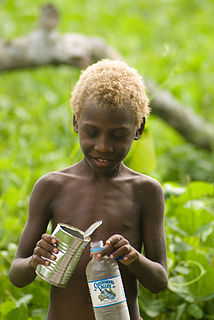
Ni-Vanuatu is a large group of closely related Melanesian ethnic groups native to the island country of Vanuatu. As such, Ni-Vanuatu are a mixed ethnolinguistic group with a shared ethnogenesis that speak a multitude of languages.

The Prince Philip movement is a religious sect followed by the Kastom people around the villages of Yaohnanen and Yakel on the southern island of Tanna in Vanuatu. It is a cargo cult of the Yaohnanen tribe, who believe in the divinity of Prince Philip, Duke of Edinburgh (1921–2021), the late consort to Queen Elizabeth II.

Religion in Vanuatu is dominated by various branches of Christianity. Vanuatu is an archipelago made up of 13 larger islands, and approximately 70 smaller surrounding islands, each home to multitudes of diverse cultural and religious communities. As of 2020, the population of approximately 300,000 people speak as many as 145 languages throughout the island nation. Approximately 82% of the population of Vanuatu is Christian. An estimated 28% is Presbyterian, 12% Roman Catholic, 15% Anglican, and 12% Seventh-day Adventist. Groups that together constitute 15% include the Church of Christ, United Pentecostal Church, Assemblies of God, Neil Thomas Ministries, the Apostolic Church and other Christian denominations.

This article presents an overview of the culture of Vanuatu.

The National Museum of Vanuatu is located in the Vanuatu Cultural Centre (VCC) in Port Vila, Vanuatu. It specializes in exhibits relating to the culture and history of this group of islands in the South Pacific. It is unique amongst Pacific national cultural institutions for rejecting many aspects of European museology, and creating new ways of working which value kastom practices.
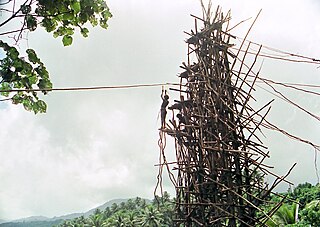
Land diving is a ritual performed by the men of the southern part of Pentecost Island, Vanuatu. Men jump off wooden towers around 20 to 30 meters high, with two tree vines wrapped around the ankles. Land diving is done by tying vines to each ankle. The tradition has developed into a tourist attraction. According to the Guinness World Records, the g-force experienced by those at their lowest point in the dive is the greatest experienced in the non-industrialized world by humans.
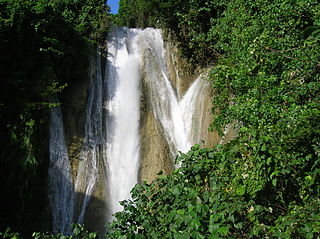
Vanuu, also known as Waterfall Village, is a large settlement on the southwestern coast of Pentecost Island in Vanuatu. The village consists of several scattered groups of houses within an ageing coconut plantation.
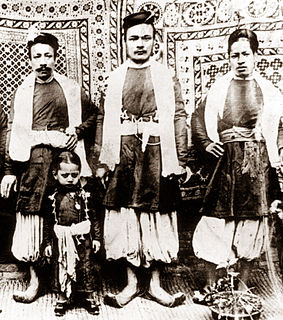
Traditional Newar clothing refers to the everyday clothes worn by the Newar people of Nepal who are indigenous to the Kathmandu Valley and surrounding regions. The garments are associated with the old aristocracy, merchants, farmers, craftsmen and professionals.
The Suku people or Basuku (plural) are an ethnic group of Bantu origin who traditionally inhabit the south-western Democratic Republic of the Congo and north-western Angola. As of 2017, there are believed to be about 200,000 people who identify as Suku, many living in the Congo's Kwango Province.


















